Day 2 of a 3 day long weekend of Early Winter tours today. After glorious sunshine yesterday, the weather forecast for today was not so good. Although it did rain at times, it wasn’t quite as bad as forecast and we did have some drier spells. Even so, it doesn’t stop us from getting out birding.
Given the forecast, we started the day in the hides at Cley. Pat’s Pool looked rather empty from Bishop Hide – perhaps a raptor had just been through and flushed a lot of the birds? There were a few Wigeon scattered round the edges and a bigger group of Teal on the island in front of the Teal Hide. A single Lapwing and a Dunlin flew back in and landed on one of the nearer islands, next to a little huddle of Black-headed Gulls.
We had arranged to meet part of the group here, off the bus, so having collected them on our way back, we made our way out towards the main complex of hides. Along the Skirts, a male Stonechat flew along the path ahead of us and sat on a fence post, watching us for a minute or so, before flying a little further back. As we continued on our way, it always stayed a discrete distance ahead of us until we got to the junction in the path.
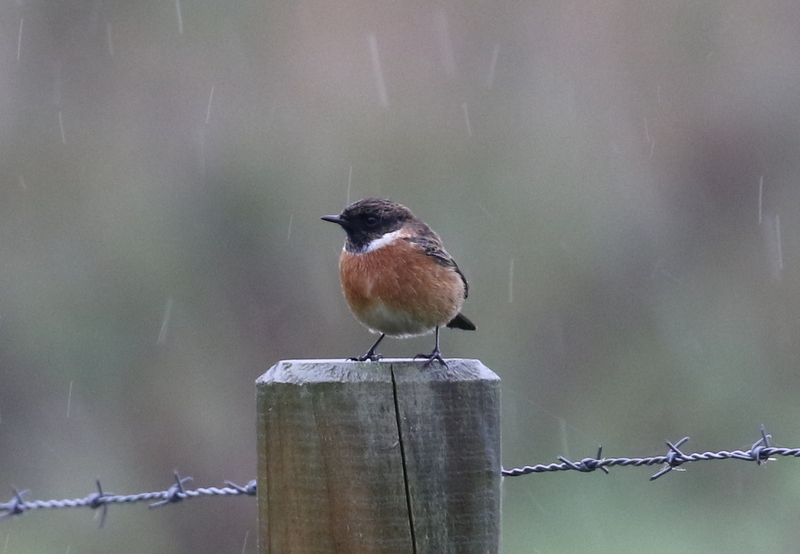 Stonechat – this male was along the Skirts path this morning
Stonechat – this male was along the Skirts path this morning
As we opened the shutters on Dauke’s Hide, a small group of Wigeon were on the bank just in front. There were more duck out on Simmond’s Scrape, a nice selection. Several Shoveler were whirling round with their heads constantly down in the water. A lot more Teal were sleeping on the flooded islands. A few Gadwall were feeding over towards the back – one of the smartest but the most underrated of ducks, we had a good look at them in the scope. A single Pintail flew over and disappeared off to the east.
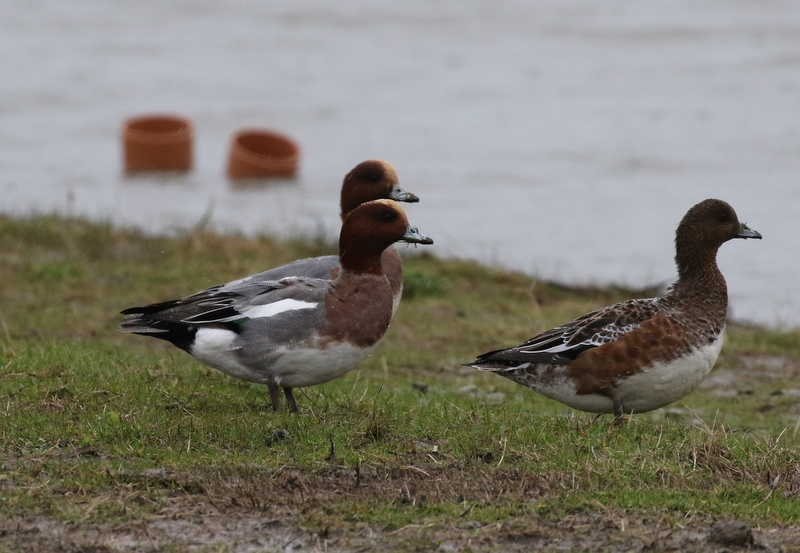 Wigeon – these three were on the bank in front of Dauke’s Hide
Wigeon – these three were on the bank in front of Dauke’s Hide
Probably avoiding the weather out on the sea, there were several Great Black-backed Gulls on Simmond’s Scrape this morning, a mixture of adults and various ages of immature birds. A single Lesser Black-backed Gull was conveniently standing on one tiny island, next to a lone Great Black-backed Gull, providing a great side-by-side comparison. As well its noticeably smaller size, we could see the yellow legs of the Lesser (pink on the Great) and its slightly paler slate grey mantle.
We could hear a pipit calling, but despite searching round the margins of the scrape, we couldn’t see it. We did see two pipits come up from Billy’s Wash, calling. They were Water Pipits but, despite flying towards us at one point, they circled back round and landed out of view on Billy’s Wash again. When the rain eased off, we decided to make our way back. We could hear Bearded Tits calling by the boardwalk, but they were tucked deep down in the reeds this morning, perhaps not a surprise given the weather.
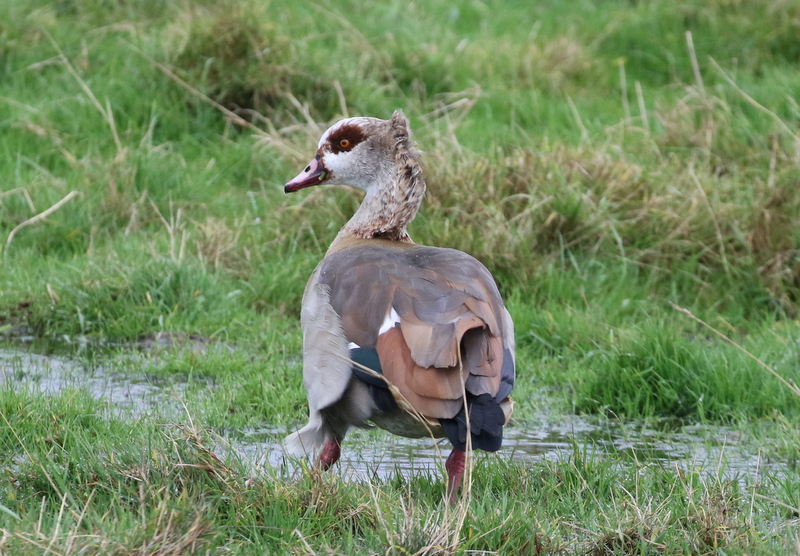 Egyptian Goose – a pair were on the grazing marsh next to Attenborough’s Walk
Egyptian Goose – a pair were on the grazing marsh next to Attenborough’s Walk
Our next destination was Iron Road, where we parked to walk out to Babcock Hide. It had stopped raining completely now and even seemed to have brightened up a little. There was a large gaggle of Greylag Geese on the grazing marshes by the start of Attenborough’s Walk and, further along by the junction to the hide, a pair of Egyptian Geese too. Several small groups of Pink-footed Geese appeared to fly up from the direction of Salthouse. Some of them flew west over the fields to the south of us, while others seemed to head straight inland over the village.
Three Marsh Harriers flew up from Pope’s Marsh and started circling together over the reedbed, presumably taking advantage of the dry weather to head off hunting. Two of them drifted off east towards Salthouse.
As we walked out to the hide, we had seen a flock of about ten Dunlin whirling round over the water before disappearing off over the reeds towards Cley. When we got into the hide, there were thankfully still two Dunlin on the mud right in front. We had great close views of them feeding just in front of us. They were both first winter birds, having mostly completed their moult but still retaining a few juvenile upperpart feathers and the odd remnant of black belly spotting.
 Dunlin – two were feeding right in front of Babcock Hide
Dunlin – two were feeding right in front of Babcock Hide
A single Little Grebe was diving in the deeper water at the back, between the islands. Nearby, were a few Teal and a single Shoveler. When we looked back, the Little Grebe had disappeared but a single female Pintail had floated out from behind the islands. It was most likely the one we had seen flying off in this direction earlier. There were a few Wigeon on here too, but not as many as in recent weeks – presumably they were feeding somewhere more sheltered today.
There were not so many other waders on here today. A couple of Redshank were picking around the edge of one of the islands. A Common Snipe flew over and dropped down beyond the reeds. However, there was a steady progression of small groups of Lapwings flying west overhead, presumably birds arrived from the continent and making their way inland.
A report came through of three Bean Geese with Pink-footed Geese between Salthouse and Kelling, so we decided to head over to have a look. On our walk back to the car, one of the Marsh Harriers was circling over the marshes just the other side of Iron Road. Two Carrion Crows decided to have a go at it and the three birds chased each other for a while. When the crows gave up and landed a short distance away, the Marsh Harrier decided to get its own back and promptly stooped at them, before drifting off back past Babcock Hide.
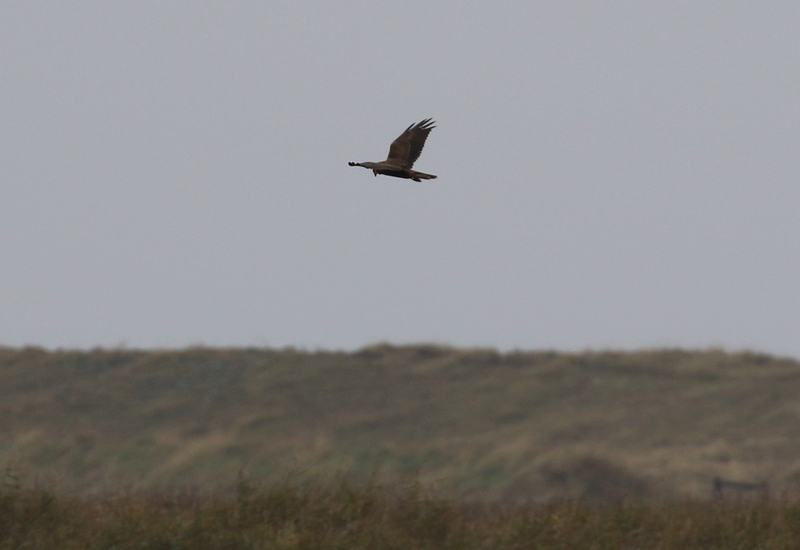 Marsh Harrier – chased by Crows over the marshes by Iron Road
Marsh Harrier – chased by Crows over the marshes by Iron Road
Unfortunately, by the time we got to the field where the Bean Geese had been, there was no sign of them. It transpired that they had only been seen there much earlier and had probably flown off with the Pink-footed Geese we had seen heading inland on our walk out to Babcock Hide. There were still about thirty Pink-footed Geese in the field so we had a look at them through the scope. In the short winter wheat, it was easy to see their pink legs and feet. Another small group flew in calling and landed with them, but they all had pink legs too.
As we drove back towards Cley again, it started to drizzle again, so we made our way round to the beach car park and had our lunch in the shelter there. While we were eating, a small flock of Golden Plover flew in over the Eye Field and circled over the grass in front of us, before flying back towards the reserve. Several little groups of Brent Geese flew in from the direction of Blakeney Freshes. We kept one eye on the sea, but there was very little moving offshore today. As we were packing up a flock of Teal flew west.
It was starting to rain a little harder now, so we retired to the visitor centre for a warming coffee. Afterwards, it seemed a good time to go exploring inland, so we drove up to Holt first. There had been some Waxwings in the trees here during the week, but we couldn’t find them today. There were just a few Blackbirds in the rowan where they had been a couple of days ago, despite there still being quite a few berries left. The trees where we had seen them last weekend, however, have now been stripped bare.
We drove further east to Felbrigg Park next. We had a look in the trees along the main drive first, but they were quiet. Down at the main car park, by the Hall, there were lots of Blackbirds on the grass. Presumably they were all or mostly continental migrants, having stopped to feed just in from the coast. A single Redwing was trying to bathe in a puddle, when the Blackbirds were not chasing after it.
 Redwing – trying to take a bath in Felbrigg Hall car park
Redwing – trying to take a bath in Felbrigg Hall car park
On our way back round, we turned into Lions Mouth. Just through the gates a load of finches flew up from the edge of the road and back into the trees, flashing white rumps as they went. Bramblings. We stopped the car and yet more flew up from down below the low brambles on the edge of the woods. We could see several of them perched in the holly trees beyond.
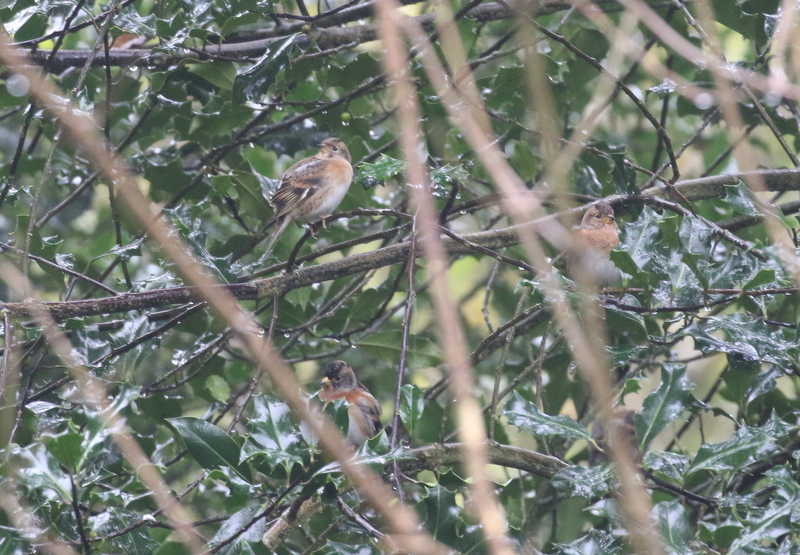 Bramblings – several perched in the holly trees
Bramblings – several perched in the holly trees
We parked in the car park and walked back to the road, standing on the verge and looking back towards the gates. Gradually, the Bramblings started to drop down again and we got them in the scope. They were dropping down to feed on beech mast and they were surprisingly well camouflaged against the fallen beech leaves, despite their bright orange breast and shoulders, particularly on the males.
It was still raining a little, so we made our way back to the car and drove down to Sheringham. By the time we got there, the rain had eased again, so we set off for a walk along the prom. There was mist offshore which meant the visibility wasn’t great, but once again there seemed to be nothing moving past. There were plenty of Herring Gulls on the sea and Great Black-backed Gulls and Cormorants adorning the end of each of the groynes.
As we walked along, we came across several Turnstones. One of them in particular was very tame and came running towards us and almost between our feet. Further along, we could see why, as people were throwing out chips for the Black -headed Gulls and the Turnstones were grabbing a share of the fallen ones too. The Turnstones had to be quick, because the Black-headed Gulls proceeded to chase a couple of them – they were fairly relentless too, pursuing them up and down along the beach and out over the sea until the Turnstones dropped their chips.
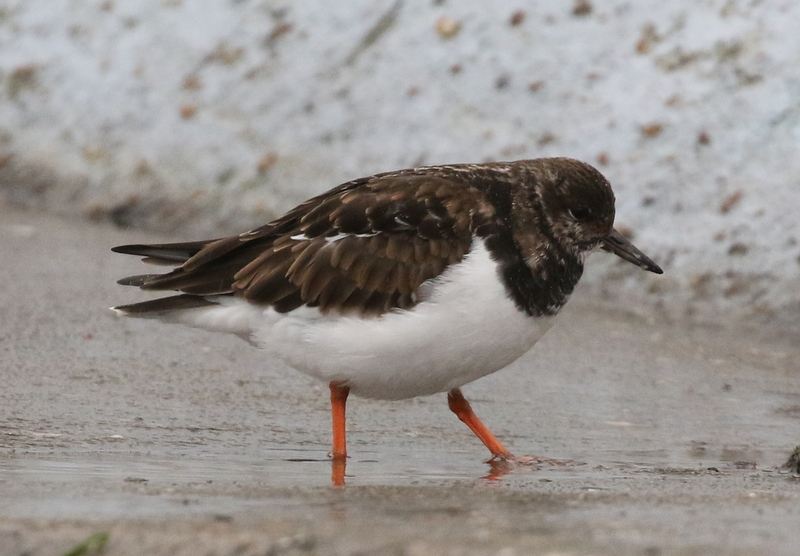 Turnstone – waiting for chips on the prom
Turnstone – waiting for chips on the prom
The rocks below the prom are a regularly wintering site for Purple Sandpipers but there didn’t seem to be at any of their regular haunts this afternoon. We walked right along to the eastern end and, as we walked past, one Purple Sandpiper appeared below us. We watched as it climbed up and down, picking around at the seaweed growing on the rock’s surface. When a wave came in and crashed in through the bottom of the rocks, a second Purple Sandpiper appeared from below and climbed up to the top of one nearby.
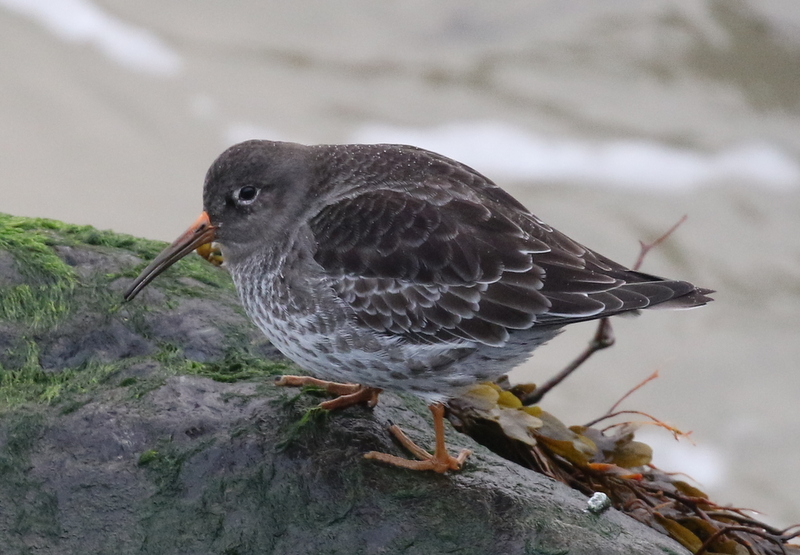 Purple Sandpiper – two were on the rocks below the prom at Sheringham
Purple Sandpiper – two were on the rocks below the prom at Sheringham
When the first Purple Sandpiper appeared, we had just seen a distant diver on the sea and when we had had a good look at both of them, we turned our attention back to looking for it. It was obviously diving as it took a while before we picked it up again. Through the scope we confirmed our suspicions – it was a Great Northern Diver. Then it disappeared again, and despite scanning back and forth for a few minutes it was nowhere to be seen. It had probably drifted back out into the mist and the light was now starting to fade so we decided to call it a day and head for home.
















